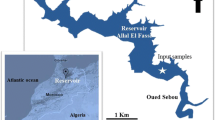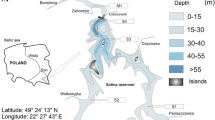Abstract
Three major reservoirs (Marne, Seine and Aube), situated in the upstream basin of the river Seine represent a storage capacity of 800 106 m3. In order to quantify the possible role of these reservoirs as a sink or source of nutrients and organic matter for the river system, an input/output mass-balance of suspended matter, organic carbon, inorganic nitrogen forms, phosphorus and reactive silica was established, providing reliable estimates of their retention/elimination and export. The study was carried out over 3 years (1993, 1994 and 1995) in differing hydrological conditions. The retention times varied from 0.3 to 0.8 year, depending on the reservoir and the year, but was longer in 1993 that was a drier year than 1994 and 1995, hydrologically quite similar.
Regarding retention (or elimination) and export, the behaviour of the three studied reservoirs was similar. A clear loss or retention of nitrogen, phosphorus and silica was observed in the reservoirs and represented about 40% of the incoming flux of nitrate, 50% of silica, and 60% of phosphate. The retention was lower for total phosphorus than for phosphate. The reservoirs are also sites of suspended matter deposition except during the decennial drawdown, when suspended matter is exported. For inorganic nitrogen, the average amount of nitrate retained in the Seine basin reservoirs upstream from Paris is 5000 tonnes y−1 that is almost equal to the estimated retention by deposition or denitrification in river channel sediments for the whole drainage network. The retention in the reservoirs represents about 12% of the total flux of nitrate at the outlet of the basin upstream from Paris, and 5% at the mouth of the Seine River.
We also calculated inlake C, N, P, Si budgets on the basis of direct process measurements. Measurements of planktonic primary and bacterial activity production led to annual net production of 4200 and 580 tonnes of carbon, respectively. A reasonable value (450 tonnes of carbon) of grazing was calculated. Corresponding N, P, Si fluxes were drawn from appropriate C:N:P:Si ratios. Benthic fluxes were measured with bell jars. The retention of P and Si represents a small fraction of important internal fluxes of phytoplanktonic uptake and recycling, while inorganic nitrogen retention depends mostly on benthic denitrification. The behaviour of P and Si differs in that P is mainly recycled in the water column, while Si dissolution occurs at the sediment interface. Nitrogen is recycled in both the planktonic and the benthic phase.
Similar content being viewed by others
References
Akopian M, Garnier J & Pourriot R (in press) A large reservoir as a source of zooplankton for the river: structure of the populations and influence of fish predation. J. Plankton Res.
Andersen VJM (1974) Nitrogen and phosphorus budgets and the role of sediments in six shallow Danish Lakes. Arch. Hydrobiol. 74: 528-550
Barillier A & Garnier J (1993) Influence of temperature and substrate concentration on bacterial growth yield in Seine River water batch cultures. Applied Environ. Microb. 59: 1678-1682
Van Bennekom AJ & Salomons W (1981) Pathways of nutrients and organic matter from land to ocean through rivers. In: Martin J-M, Burton JD & Eisma (Eds) River Inputs to Ocean Systems (pp 33-51). UNEP, IOC, SCOR, United Nations, New York
Billen G, Garnier J & Hanset Ph (1994) Modelling phytoplankton development in the entire drainage network: The RIVERSTRAHLER model applied to the Seine River system. Hydrobiologia 289: 119-137
Billen G & Garnier J (1998) Chapitre 10. Les sels nutritifs: l'ouverture des cycles. In: Meybeck M, de Marsily G & Fustec E (Eds) La Seine en son Bassin. Elsevier, Paris, in press
Billen G, Lancelot C & Meybeck M (1991) N, P, Si retention along the aquatic continuum from land to sea. In: Mantoura RFC, Martin JM & Wollast R (Eds) Ocean Margin Process in Global Change. John Wiley & Sons Ltd
Conley D & Kilham SS (1989) Differences in silica content between marine and freshwater diatoms. Limnol. Oceanogr. 34: 205-213
Cooke GD, Welch EB, Peterson SA & Newroth PR (1993) Restoration and Management of Lakes and Reservoirs. Lewis Publishers, U.S.A.
Eberlein K & Katter G (1984) Automatic method for the determination of orthophosphate and dissolved phosphorus in the marine environment. Fresenius Z. Anal. Chem. 326: 354-357
Forsberg RB (1985) The fate of planktonic primary production. Limnol. Oceanogr. 30: 807-819
Fuhrman JA & Azam F (1980) Bacterioplankton secondary production estimates for coastal waters of British Columbia, Antartica, and California. Appl. Envir. Microb. 39: 1085-1095
Fuhrman JA & Azam F (1982) Thymidine incorporation as a measure of heterotrophic bacterioplankton production in marine surface waters: evaluation and field results. Mar. Biol. 66: 109-120
Galicka W & Penczak T (1989) Total nitrogen and phosphorus budgets in the lowland Sulejow Reservoir. Arch. Hydrobiol. 117: 177-190
Garnier J. & Mourelatos S. (1991) Contribution of grazing in phytoplankton overall losses in a shallow lake (Créteil Lake, France). Freshwater Biology 25: 515-523
Garnier J, Billen G & Coste M (1995) Seasonal succession of diatoms and Chlorophyceae in the drainage network of the river Seine: Observations and modelling. Limnol. Oceanogr. 40: 750-765
Garnier J, Billen G & Levassor A (1998) Chapitre 5. Fonctionnement et impacts écologiques des réservoirs de Champagne. In: Meybeck M, de Marsily G, Fustec E. (Eds) La Seine en son Bassin. Elsevier, Paris, pp 263-300
Garnier J, Billen G, Sanchez N & Leporcq B (submitted) Ecological functioning of a large reservoir in the upstream basin of the Seine River (Marne reservoir, france): a modelling approach. Arch. Hydrobiol.
Gunnison D (1985) Microbial processes in reservoirs. Development in Hydrobiologia, 27, Dumont H (series Ed)
Jansson M, Andersson R, Berggren H & Leonardson L (1994) Wetlands and lakes as nitrogen traps. Ambio 23(6): 320-325
Jumars PA, Penry DL, Baroos JA, Perry M-J & Frost BW (1989) Closing the microbial loop: dissolved organic carbon pathway to heterotrophic bacteria from imcomplete ingestion, digestion and adsorption in animals. Deep Sea Research 4: 483-495
Humborg C, Ittekot V, Cosiascu A & Bodungen BV (1997) Effect of Danube River dam on Black sea biogeochemistry and ecosystem structure. Nature 386: 385-388
Kelly CA, Rudd JWM, Hesslein RH, Schindler DW, Dillon PJ, Driscoll CT, Gherini SA & Hecky RE (1987) Prediction of biological acid neutralisation in acid-sensitive lakes. Biogeochemistry 3: 129-140
Lampert W (1978) Release of dissolved organic carbon by grazing zooplankton. Limnol. Oceanogr. 3: 831-834
Likens GE & Loucks OL (1978) Analysis of five North American lake ecosystems. III. Sources, loading and fate of nitrogen and phosphorus. Verh. Internat. Verein. Limnol. 20: 568-573
Lijklema L, Jansen H & Roijackers RMM (1989) Eutrophication in the Netherlands. Wat. Sci. Tech. 21: 1899-1902
Lorenzen CJ (1967) Determination of chlorophyll and phaeopigments: spectrophotometric equations. Limnol. Oceanogr. 12: 343-346
Martin C & Romain A (1998) Temporal variability of particulate input, output and retention in the three reservoirs of the ‘Grands Lacs de Seine’ (1993–1996). Hydrobiologia, in press
Molot LA & Dillon PJ (1993) Nitrogen mass-balances and denitrification rates in Central Ontario Lakes. Biogeochemistry 20: 195-212
Officer CB & Ryther JH (1980) The possible importance of silicon in marine eutrophication. Mar. ecol. Prog. Ser. 3: 83-91
Pourriot R & Meybeck M (1995) Limnologie générale. Masson, Paris
Rodier J (1984) L'analyse de l'eau. 7ème édition. Dunot
Sanchez N (1997) Le processus de dénitrification dans les sédiments du barrage-réservoir de la Marne. Etude de sa cinétique et modélisation. Thèse Doct. Sci. Eau, Université. P. & M. Curie, Paris 6
Schelske CL (1985) Biogeochemical silica mass balances in Lake Michigan and Lake Superior. Biogeochemistry. 1: 197-218
Serruya C (1975) Nitrogen and phosphorus balances and load-biomass relationship in Lake Kinneret (Israel). Verh. Internat. Verein. Limnol. 19: 1357-1369
Seitzinger SP (1988) Denitrification in freshwater and coastal marine ecosystem. Limnol. Oceanogr. 29: 73-83
Seitzinger SP (1994) Linkage between organic matter mineralization and denitrification in eight riparian wetlands. Biogeochem. 25: 19-39
Slavyck G & McIsaac JJ (1972) Comparison of two automated ammonium methods in a region of coastal upwelling. Deep-Sea Res. 19: 1-4
Sommer U, Gliwicz ZM, Lampert W & Duncan A (1986) The PEG-model of seasonal succession of planktonic events in fresh waters. Arch. Hydrobiol. 106(4): 433-471
Steemann Nielsen E (1952) The use of radioactive carbon (14C) for measuring organic production in the sea J. Cons. Perm. Int. Expl. Mer. 18: 117-140
Straskrabova V, Brandl Z, Henderson-Sellers B, Lind OT, Sladecek V & Talling JF (1990) Proceedings of the International Conference on Reservoir Limnology and Water quality. Arch. Hydrobiol. Ergebn. Limnol. Vol. 33
Tilman D, Kilham SS & Kilham P (1982) Phytoplankton community ecology: the role of limiting nutrients. Annu. Rev. Ecol. Syst. 13: 349-372
Thibert S (1994) Exportations naturelles et anthropiques des ions majeurs et des éléments nutritifs dans le bassin de la Seine. Approches méthodologiques. Thèse Doct. Sci. Eau, Université. P. & M. Curie, Paris 6
Thornton KW, Kimmel BL & Payne FE (1990) Reservoir Limnology. Ecological Perspectives. John Wiley & Sons, Inc
Vollenweider RA (1968) Scientific fundamentals of the eutrophication of lakes and flowing waters with particular references to nitrogen and phosphorus as factors of eutrophication. O.C.D.E. Paris, Technical Report, DA 5/SCI/68.27
Vörösmarty CJ, Meybeck M, Fekene B & Sharma K (1997) The potential impact of neo-Castorization on sediment transport by the global network of rivers. In: Human Impact on Erosion and Sedimentation (Proceedings of the Rabat Symposium, April 1997), IAHS Publ, no 245
Wetzel RG (1983) Limnology, 2nd edn. Saunders College Publishing, New York
Windolf J, Jeppensen E, Jensen JP & Kristensen P (1996) Modelling of seasonal variations in nitrogen retention and in-lake concentration: a four-year mass balance study in 16 shallow Danish lakes. Biogeochemistry 33: 25-44
Author information
Authors and Affiliations
Rights and permissions
About this article
Cite this article
Josette, G., Leporcq, B., Sanchez, N. et al. Biogeochemical mass-balances (C, N, P, Si) in three large reservoirs of the Seine Basin (France). Biogeochemistry 47, 119–146 (1999). https://doi.org/10.1023/A:1006101318417
Issue Date:
DOI: https://doi.org/10.1023/A:1006101318417




